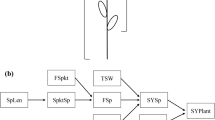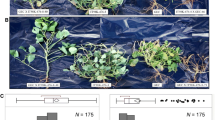Abstract
Phenotypic and genetic evaluation of morphological traits associated with herbage biomass production was undertaken in a perennial ryegrass (Lolium perenne L.) biparental F1 mapping population (n = 200) with parent plants from cultivars ‘Grasslands Impact’ and ‘Grasslands Samson’. Morphological traits measured on three clonal replicates of the parental genotypes and 200 F1 progeny in a glasshouse in two separate trials (autumn and spring) included: dry weight (DW), leaf elongation rate (LER), initial tiller number (TNs), final tiller number (TNe), site filling (Fs), tiller weight (TW), leaf lamina length, leaf tip and ligule appearance rates (ALf, ALg) and leaf elongation duration (LED). Principal component analysis of patterns of trait association identified negative correlation between TNs or TNe, and TW as the primary basis for morphological difference and indicated that either high LER or long LED could reduce TN. Plants with higher LER tended to have increased DW. Quantitative trait loci (QTL) were detected on all seven linkage groups (LG) of a perennial ryegrass linkage map for all but three traits. A total of 61 QTL were identified, many of which clustered at 15 shared genome locations. Significant genotype by environment effects were encountered, evidenced both by variation between experiments in genotype rankings and by a general lack of commonality for QTL for the same traits in the different experiments. Only five QTL, for ALf, ALg and TN, were conserved between autumn and spring trials. A QTL for TN and DW on LG6 is a strong candidate for application of MAS in future plant improvement work and was found to be co-linear with QTL for equivalent traits reported on chromosome 2 in rice.


Similar content being viewed by others
References
Bahmani I, Hazard L, Varlet-Grancher C, Bétin M, Lemaire G, Matthew C, Thom ER (2000) Differences in tillering of long- and short-leaved ryegrass genetic lines under full light and shade treatments. Crop Sci 40:1095–1102
Bahmani I, Thom ER, Matthew C, Lemaire G (2001) Productivity of grazed perennial ryegrass dairy pastures from different ecotypes under nitrogen and irrigation treatments. NZ J Agric Res 44:123–133
Barre P, Mi F, Balfourier F, Ghesquiere M (2002) QTLs of lamina length in Lolium perenne. In: Durand JL, Emile JC, Huyghe C, Lemaire G (eds) Multi-function grasslands: quality forages, animal products and landscapes. Proceedings of the 19th general meeting of the European Grassland Federation. European Grassland Federation, Versailles, pp 278–279
Barre P, Moreau L, Mi F, Turner L, Gastal F, Julier B, Ghesquière M (2009) Quantitative trait loci for leaf length in perennial ryegrass (Lolium perenne L.). Grass Forage Sci 64:310–321
Barrett B, Baird I, Woodfield D (2008) White clover seed yield: a case study in marker assisted selection. In: Yamada T, Spangenberg G (eds) Molecular breeding of forage and turf: proceedings of the 5th international symposium, Sapporo, Japan. Springer, New York, pp 241–250
Beavis WD (1994) The power and deceit of QTL experiments: lessons from comparative QTL studies. In: Wilkinson DB (ed) Proceedings of the 49th annual corn and sorghum research conference, Chicago. American Seed Trade Association, Washington, DC, pp 250–266
Brownstein MJ, Carpten JD, Smith JR (1996) Modulation of non-templated nucleotide addition by Taq DNA polymerase: primer modifications that facilitate genotyping. BioTechniques 20:1004–1010
Burton GW, DeVane EH (1953) Estimating heritability in tall fescue (Festuca arundinacea) from replicated clonal material. Agron J 45:478–481
Chapman DF, Lemaire G (1993) Morphogenic and structural determinants of plant regrowth after defoliation. In: Proceedings XVII international grassland congress, NZGA, pp 95–104
Churchill DA, Doerge RW (1994) Empirical threshold values for quantitative trait mapping. Genetics 138:963–971
Davies A, Thomas H (1983) Rates of leaf and tiller production in young spaced perennial ryegrass plants in relation to soil-temperature and solar-radiation. Ann Bot 51:591–597
Dolstra O, Denneboom C, de Vos ALF, van Loo EN (2007) Marker-assisted selection for improving quantitative traits of forage crops. In: Guimaraes EP, Ruane J, Scherf BD, Sonnino A, Dargie JD (eds) Marker-assisted selection: current status and future perspectives in crops, livestock, forestry and fish. FAO, Rome, pp 59–65
Donaghy DJ (1999) Tasmanian Institute of Agricultural Research. The role of stolon formation in survival of ‘Impact’ perennial ryegrass plants over summer in Tasmania. Report to Tasmanian Institute of Agricultural Research, p 15
Donald CM (1968) The breeding of crop ideotypes. Euphytica 17:385–403
Emebiri LC, Devey ME, Matheson AC, Slee MU (1998) Age-related changes in the expression of QTLs for growth in radiata pine seedlings. Theor Appl Genet 97:1053–1061
Faville MJ, Vecchies AC, Schreiber M, Drayton MC, Hughes LJ, Jones ES, Guthridge KM, Smith KF, Sawbridge T, Spangenberg GC, Bryan GT, Forster JW (2004) Functionally associated molecular genetic marker map construction in perennial ryegrass (Lolium perenne L.). Theor Appl Genet 110:12–32
Fulton TM, Chunwongse J, Tanksley SD (1995) Microprep protocol for extraction of DNA from tomato and other herbaceous plants. Plant Mol Biol Report 13:207–209
Gautier H, Varlet-Grancher C, Hazard L (1999) Tillering responses to the light environment and to defoliation in populations of perennial ryegrass (Lolium perenne L.) selected for contrasting leaf length. Ann Bot 83:423–429
Grattapaglia D, Sederoff R (1994) Genetic linkage maps of Eucalyptus grandis and Eucalyptus urophylla using a pseudo-testcross: mapping strategy and RAPD markers. Genetics 137:1121–1137
Groot JC, Lantinga EA, Neuteboom JH, Deinum B (2003) Analysis of the temperature effect on the components of plant digestibility in two populations of perennial ryegrass. J Sci Food Agric 83:320–329
Hernández Garay A, Hodgson J, Matthew C (1993) Spring grazing management and tiller dynamics in a ryegrass/white clover pasture. Proc NZ Grassl Assoc 55:133–136
Hernández Garay A, Matthew C, Hodgson J (1999) Tiller size/density compensation in perennial ryegrass miniature swards subject to differing defoliation heights and a proposed productivity index. Grass Forage Sci 54:347–356
Humphreys MO (2005) Genetic improvement of forage crops—past, present and future. J Agric Sci 143:441–448
Humphreys M, Turner L (2001) Molecular markers for improving nutritive value in perennial ryegrass. Plant Breeding: Sustaining the Future: XVIth EUCARPIA Congress, Edinburgh, Scotland
Jensen LB, Andersen JR, Frei U, Xing Y, Taylor C, Holm PB, Lubberstedt T (2005) QTL mapping of vernalization response in perennial ryegrass (Lolium perenne L.) reveals co-location with an orthologue of wheat VRN1. Theor Appl Genet 110:527–536
Jones ES, Dupal MP, Dumsday JL, Hughes LJ, Forster JW (2002a) An SSR-based genetic linkage map for perennial ryegrass (Lolium perenne L.). Theor Appl Genet 105:577–584
Jones ES, Mahoney NL, Hayward MD, Armstead IP, Jones JG, Humphreys MO, King IP, Kishida T, Yamada T, Balfourier F, Charmet G, Forster JW (2002b) An enhanced molecular marker based genetic map of perennial ryegrass (Lolium perenne) reveals comparative relationships with other Poaceae genomes. Genome 45:282–295
Knott SA, Neale DB, Sewell MM, Haley CS (1997) Multiple marker mapping of quantitative trait loci. Theor Appl Genet 94:810–820
Kosambi DD (1944) The estimation of map distances from recombination values. Ann Eugen 12:172–175
Lerceteau E, Szmidt AE, Andersson B (2001) Detection of quantitative trait loci in Pinus sylvestris L. across years. Euphytica 121:117–122
Liu G-F, Yang J, Zhu J (2006) Mapping QTL for biomass yield and its components in rice (Oryza sativa L.). Acta Genet Sin 33:607–616
Matthew C, Lemaire G, Sackville Hamilton NR, Hernández Garay A (1995) A modified self-thinning equation to describe size/density relationships for defoliated swards. Ann Bot 76:579–587
Nelson CJ, Zarrough KM (1981) Tiller density and tiller weight as yield determinants of vegetative swards. In: Wright CE (ed) Plant physiology and herbage production. Occasional symposium no. 13. The British Grassland Society, Hurley, pp 25–29
Philipson MN, Christey MC (1986) The relationship of host and endophyte during flowering, seed formation, and germination of Lolium perenne. NZ J Bot 24:125–134
Saha MC, Mian MAR, Eujayl I, Zwonitzer JC, Wang LJ, May GD (2004) Tall fescue EST-SSR markers with transferability across several grass species. Theor Appl Genet 109:783–791
Saha MC, Mian R, Zwonitzer JC, Chekhovskiy K, Hopkins AA (2005) An SSR- and AFLP-based genetic linkage map of tall fescue (Festuca arundinacea Schreb.). Theor Appl Genet 110:323–336
Sartie AM, Easton HS, Matthew C (2009) Plant morphology differences in two perennial ryegrass cultivars. NZ J Agric Res 52:391–398
Sawbridge T, EngKok O, Binnion C, Emmerling M, McInnes R, Meath K, Nguyen N, Nunan K, O’Neill M, O’Toole F, Rhodes C, Simmonds J, Pei T, Wearne K, Webster T, Winkworth A, Spangenberg G (2003) Generation and analysis of expressed sequence tags in perennial ryegrass (Lolium perenne L.). Plant Sci 165:1089–1100
Schuelke M (2000) An economic method for the fluorescent labeling of PCR fragments. Nat Biotechnol 18:233–234
Sewell MM, Bassoni DI, Megraw RA, Wheeler NC, Neale DB (2000) Identification of QTLs influencing wood property traits in loblolly pine (Pinus taeda L.). I. Physical wood properties. Theor Appl Genet 101:1273–1281
Sewell MM, Davis MF, Tuskan GA, Wheeler NC, Elam CC, Bassoni DI, Neale DB (2002) Identification of QTLs influencing wood property in loblolly pine (Pinus taeda L.). II. Chemical wood properties. Theor Appl Genet 104:214–222
Sim ST, Chang T, Curley J, Warnke SE, Barker RE, Jung G (2005) Chromosomal rearrangements differentiating ryegrass genome from the Triticeae, oat, and rice genomes using common heterologous RFLP probes. Theor Appl Genet 110:1011–1019
Simon JC, Lemaire G (1987) Tillering and leaf area index in grasses in the vegetative phase. Grass Forage Sci 42:383–1380
Sleper DA, Nelson CJ, Asay KH (1977) Diallel and path coefficient analysis of tall fescue (Festuca arundinacea) regrowth under controlled conditions. Can J Genet Cytol 19:557–564
Sparnaaij LD, Bos I (1993) Component analysis of complex characters in plant breeding. 1. Proposed method for quantifying the relative contribution of individual components to variation of the complex character. Euphytica 70:225–235
Stendal CA, Casler MD, Jung G (2006) Marker-assisted and phenotypic selection for neutral detergent fiber concentration in smooth bromegrass. Crop Sci 46:303–311
Takehisa H, Shimodate T, Fukuta Y, Udea T, Yano M, Yamaya T, Kameya T, Sato T (2004) Identification of quantitative trait loci for plant growth of rice in paddy field flooded with salt water. Field Crops Res 89:85–95
Turner LB, Cairns AJ, Armstead P, Ashton J, Skøt K, Whittaker D, Humphreys MO (2006) Dissecting the regulation of fructan metabolism in perennial ryegrass (Lolium perenne) with quantitative trait locus mapping. New Phytol 169:45–58
Van Loo EN (1992) Tillering, leaf expansion and growth of plants of two cultivars of perennial ryegrass grown using hydroponics at two water potentials. Ann Bot 70:511–518
Van Ooijen JW, Voorrips RE (2001) JoinMap 3.0 software for the calculation of genetic linkage maps. Plant Research International, Wageningen
Van Ooijen JW, Boer MP, Jansen RC, Maliepaard C (2002) MapQTL4.0, Software for calculation of QTL positions on genetic maps. Plant Research International, Wageningen
Volenec JJ, Nelson CJ (1983) Response of tall fescue leaf meristem to N fertilisation and harvest frequency. Crop Sci 23:720–724
Woodfield DR, Easton HS (2004) Advances in pasture plant breeding for animal productivity and health. NZ Vet J 52:300–310
Yamada T, Jones ES, Cogan ION, Vecchies AC, Nomura T, Hisana H, Shimamoto Y, Smith KF, Hayward MD, Forster JW (2004) QTL analysis of morphological, developmental, and winter hardiness-associated traits in perennial ryegrass. Crop Sci 44:925–935
Yan JQ, Zhu J, CX He, Benmoussa M, Wu P (1998) Quantitative trait loci analysis for the developmental behaviour of tiller number in rice (Oryza sativa L.). Theor Appl Genet 97:267–274
Zarrough KM, Nelson CJ, Coutts JH (1983) Relationship between tillering and herbage yield of tall fescue. 2. Pattern of tillering. Crop Sci 23:338–342
Zhang N, Xu Y, Akash M, McCouch S, Oard JH (2004) Identification of candidate markers associated with agronomic traits in rice using discriminant analysis. Theor Appl Genet 110:721–729
Acknowledgments
This work was supported by New Zealand Foundation for Research, Science and Technology (FRST), by a Bright Futures Fellowship (initially FRST but responsibility transferred to the Tertiary Education Commission), Agricom New Zealand Ltd (now part of PGG Wrightson Seeds) and AgResearch Ltd.
Author information
Authors and Affiliations
Corresponding author
Rights and permissions
About this article
Cite this article
Sartie, A.M., Matthew, C., Easton, H.S. et al. Phenotypic and QTL analyses of herbage production-related traits in perennial ryegrass (Lolium perenne L.). Euphytica 182, 295–315 (2011). https://doi.org/10.1007/s10681-011-0400-7
Received:
Accepted:
Published:
Issue Date:
DOI: https://doi.org/10.1007/s10681-011-0400-7




